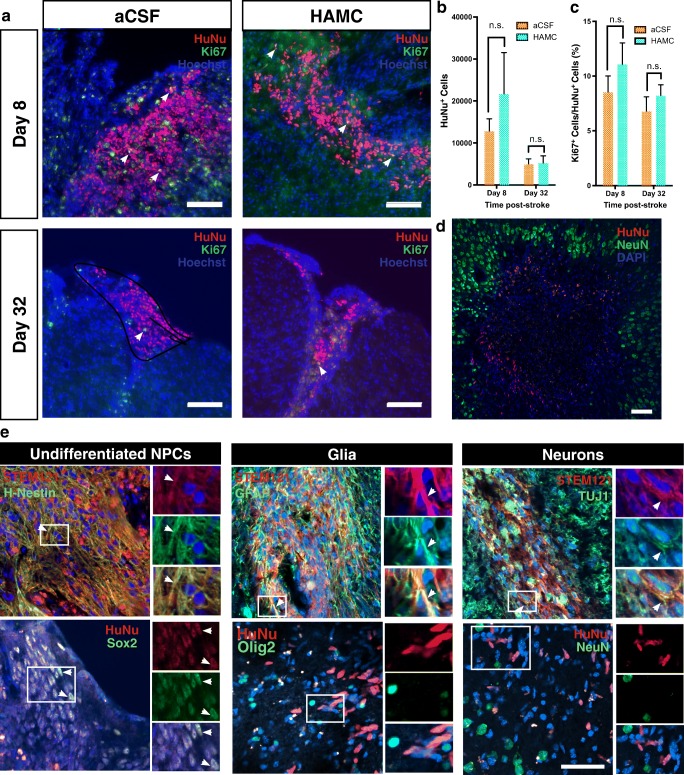Fig. 4.
Transplanted drNPCs can survive and proliferate in the stroke-injured cortex. a HuNU+ (red) drNPCs are seen within the stroke-injured cortex of SCID/Beige mice at 8 and 32 days post-stroke. A subpopulation of HuNu+ cells are Ki67+ (green) at both survival times. b The number of HuNu+ drNPCs found within the stroke-injured cortex at 8 or 32 days post-stroke was not significantly different between cells transplanted in aCSF or HAMC (8 days, p = 0.34; 32 days, p = 0.99). Significantly fewer HuNu+ cells were observed between 8 and 32 days post-stroke when transplanted in HAMC (p = 0.019) but not aCSF (p = 0.34). c There was no significant difference between transplant vehicles in the percentage of Ki67+/HuNu+ drNPCs at 8 or 32 days post-stroke (day 8, p = 0.49; day 32, p = 0.79). There was also no significant difference in Ki67+/HuNu+ drNPCs between 8 and 32 days within each vehicle group (aCSF, p = 0.66; HAMC, p = 0.46). Percent of ki67+/HuNu+ drNPCs at Day 8, 8.5% ± 1.5 (aCSF) and 11.0% ± 2.0 (HAMC); and Day 32, 6.8% ± 1.3 (aCSF) and 8.2% ± 1.0 (HAMC). d IHC reveals that drNPCs (HuNu+) remain at the boundary of the stroke injury (demarcated by NeuN+ cells) following transplantation into the stroke-injured cortex 4 days post-stroke. e Surviving drNPCs at 32 days post-stroke mostly remain undifferentiated (Sox2, Nestin). The majority of differentiated drNPCs primarily gave rise to astrocytes (GFAP), while a smaller population gave rise to immature neurons (TUJ1). No drNPCs differentiated to mature neurons (NeuN) or oligodendrocytes (Olig2). Data are represented as mean ± SEM, a Arrowheads indicate Ki67+/HuNu+ cells. e Arrowheads indicate colocalization between markers. a, d Scale bars = 100 μm (b), n = 4 for both vehicles at day 8 and n = 7 for both vehicles at day 32. cn = 4 for both vehicles at day 8, and n = 6 for aCSF and n = 3 for HAMC at day 32 (e) Scale bar = 50 μm, at least three brains were analyzed per marker and representative images were used

